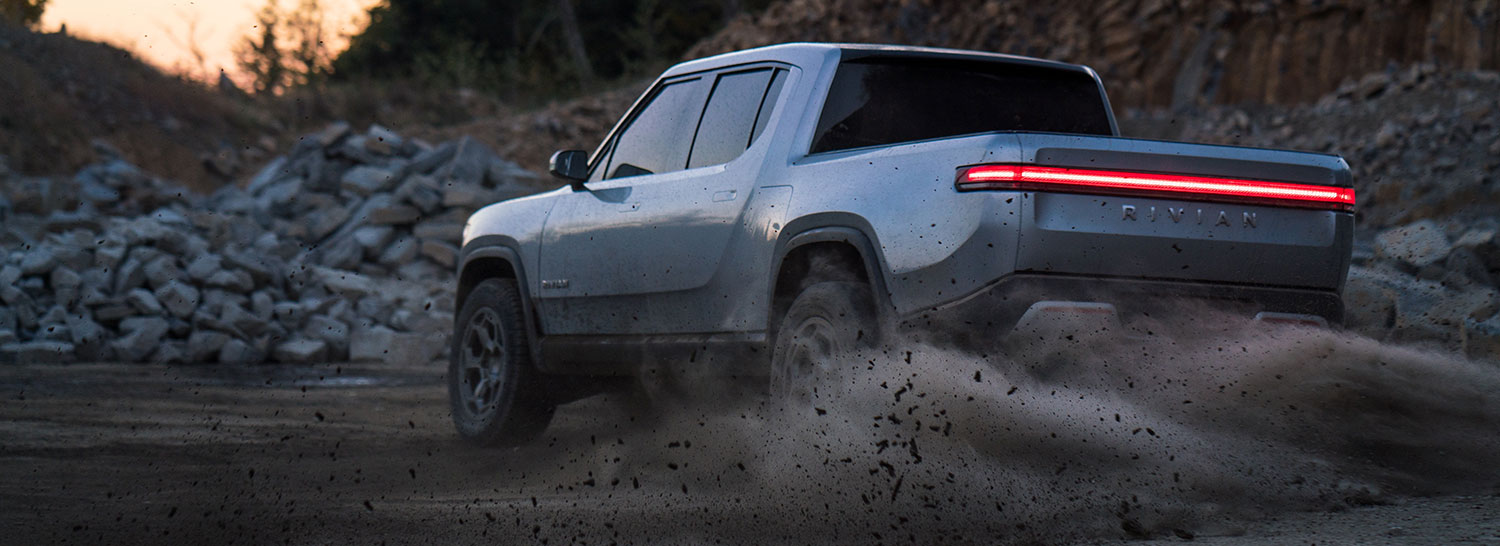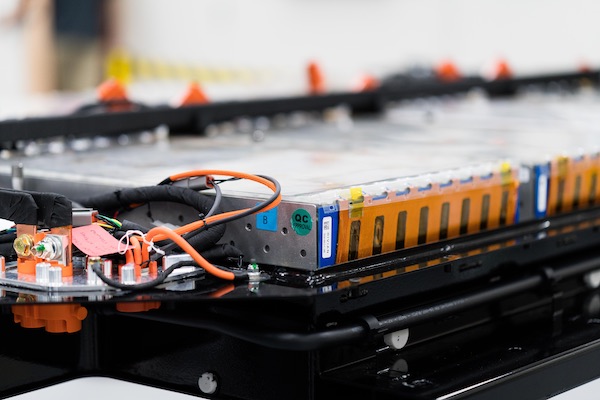
The R1T five-passenger electric pickup has a unique quad-motor AWD design. Image Courtesy of Rivian.
Rivian Off Roads Electric Vehicle Design
Startup leverages “clean slate” design for a set of adventure electric vehicles that push boundaries on battery, off-road performance.
Latest News
January 28, 2019
Think high-performance, high-utility adventure vehicle, and electric drive trains hardly spring to mind. Yet that was the hill Rivian was determined to climb as the well-funded electric vehicle start up set out to design a family of electric adventure vehicles intended to redefine the traditional pickup and SUVs categories.
The R1T, a five-passenger electric pickup, and the R1S, a seven-passenger SUV, were officially unveiled last year and are slated for commercial availability at the end of 2020. With more than 400 miles in electric range, an array of innovative storage space, and a unique design that delivers precise control of a quad-motor AWD, the Rivian vehicles push the boundaries of existing EV performance by starting with a clean slate design rather than scaling limits imposed by existing architectures.
“Putting a car into production is extremely challenging … and the reason why I’m here is that doing an electric architecture from scratch is really significant,” explains Mark Vinnels, Rivian’s executive director of engineering and programs who hails from venerable, boutique car makers like Lotus and MacLaren. “Starting from a clean sheet of paper allows us to take advantage of a true electric vehicle architecture that isn’t encumbered by an existing platform. It’s a breath of fresh air and a key enabler to design something truly unique.”
“Being immersed in the VR experience let us blow through design reviews extremely quickly.”
The foundation of both the R1T and R1S is the Rivian skateboard platform, an efficient design that packages the battery pack, drive units, suspension, braking and thermal system below the height of the wheel while allowing for a low center of gravity to deliver agility and stability. To meet the high performance benchmark for a utility vehicle, especially one designed for off-roading, Rivian traded up the traditional large motor design for a quad-motor system that delivers 147kW torque control to each wheel, aiding in maximum performance for high-speed turns and off-roading. The skateboard design also leaves room for ample passenger space as well as the opportunity to carve out unique cargo areas to store gear.

“The individual motors are completely different and far more advanced and accurate than anything you could do with a conventional gearbox and differentials,” Vinnels says. “It’s a game changer in terms of off-road driving.”
Rivian’s battery is another area of innovation. Increasing energy density was a critical design goal. The team came up with an approach that employs two layers of tightly packed, cylindrical cells separated by a cold plate, which allows for better thermal conduction and greater efficiency, Vinnels says. Currently, Rivian’s battery efficiency is 25% better than comparable EVs in the market because it can store more cells in a smaller space and deliver greater range—up to 400 miles on a charge.

Rivian claims its battery holds 25% more energy per unit volume than competitors thanks to a design that leverages tightly packaged cylindrical cells separated by a cold plate. Image Courtesy of Rivian.
The skateboard platform gives Rivian a solid foundation upon which to build future iterations of these vehicles—an approach it’s mirroring with the car’s connectivity and digital experience. Like the model pioneered by Tesla, the in-car system operates on a high-speed Ethernet backbone, which supports over-the-air updates of vehicle software to deliver new functionality and improve performance. The vehicles also connect to a cloud-based ecosystem so in-field performance data can be leveraged, with help from machine learning, to make adjustments, improve performance and enable predictive maintenance services. As part of the digital capabilities, Rivian has equipped the vehicles with cameras, lidar, radar, ultrasonic, and high-precision GPS and maps to enable “Level 3” autonomy.
While Vinnels doesn’t believe consumers are ready for “Level 4” fully autonomous vehicles quite yet, he says it’s important to include base capabilities as part of the core platform. “It’s important for us to have a strong foundation that will enable development not just for this vehicle, but for the future,” he explains. “If someone is out on the trail, exhausted, it’s nice to be able to get home in a relaxed way with a connected vehicle specification.”
Much like the Rivian adventure vehicles, the 500-person engineering team relied on a development approach that taps into state-of-the-art 3D modeling and simulation technology. The team relied on a robust simulation stack throughout the entire development process, from stress testing through safety crash tests and aerodynamics. Virtual reality was a critical tool for collaboration and advancing the interior and exterior design of the vehicles, and 3D printing was used regularly to speed up the prototyping and design process.
“Being immersed in the VR experience let us blow through design reviews extremely quickly,” he says. “Traditional processes are slow and laborious requiring hard models and working with colors and swatches. This vastly sped up the process of how we design.”
Subscribe to our FREE magazine, FREE email newsletters or both!
Latest News
About the Author
Beth Stackpole is a contributing editor to Digital Engineering. Send e-mail about this article to [email protected].
Follow DE





